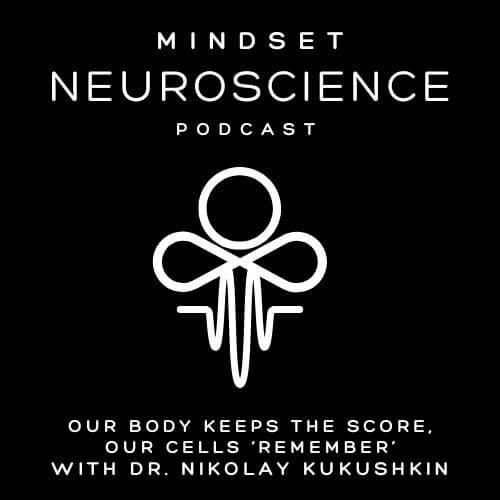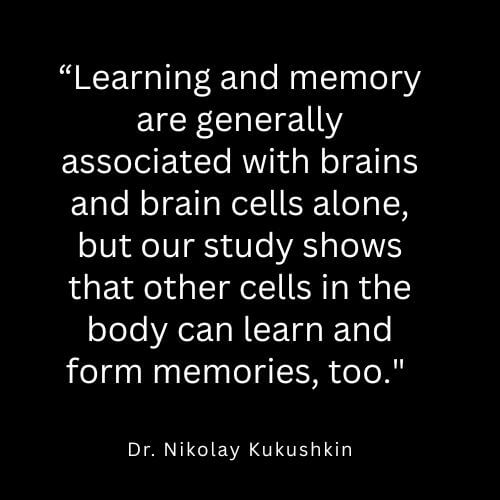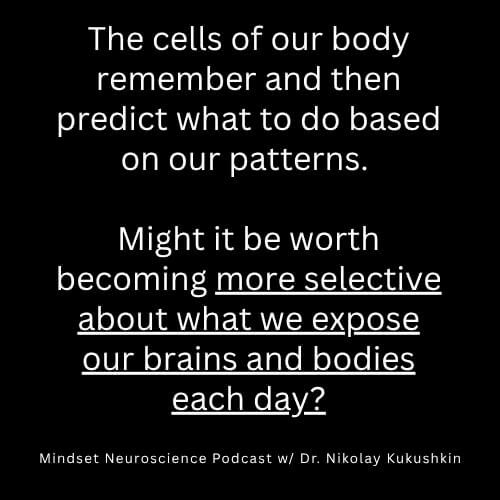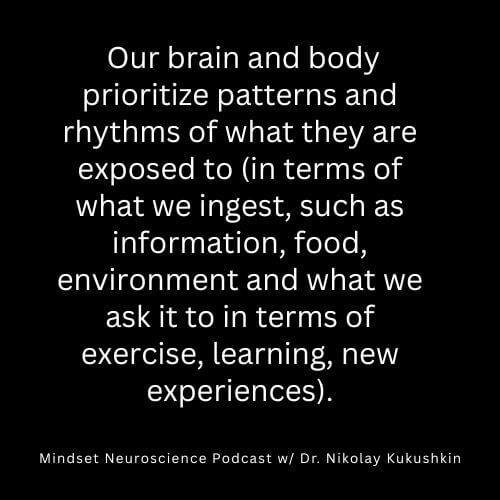Memory is not just in the brain.
Many of you have heard of the book, The Body Keeps the Score by Bessel Van der Kolk. The main idea of the book is that memory is not just something contained in the brain, but that the actual cells and tissues of our body store our past experiences.
This body-stored memory can often affect our current life in ways that we may not necessarily understand or be conscious of. Niko's work is bringing a new understanding and validation to this idea on a cellular and molecular level.
“Learning and memory are generally associated with brains and brain cells alone, but our study shows that other cells in the body can learn and form memories, too." (Kukushkin, 2024)

Listen to this episode on
What does the existence of such cellular memories mean for everyday life?
This is still a new frontier, but it does bring a lot of validation to the idea from books like the Body Keeps the Score that what we experience, such as trauma - could be indeed stored as memory that is spread out throughout the body and outside of the brain. Research shows that non-brain cells have memory, and this memory could potentially store such changes.
For example, cells in the pancreas respond to sugar in the blood by releasing the hormone insulin, which causes sugar to be absorbed. If you expose those cells to a large amount of sugar at once, then wait twenty minutes and do it again, the second time they will release twice as much insulin as the first time (O-Connor, 1980) .
As Nikkolay asserts, this makes biological sense: it is the body’s way of predicting that more sugar is on its way, and it needs to prepare for this by increasing its sugar-absorbing ability - even before the sugar arrives (Kukushkin, 2025a).
Another example is that bones become stronger the more they are repeatedly bent. They detect and then predict mechanical load, and then respond to this pattern by increasing bone formation (Turner 1994).

This pattern detection from your cells means that things we do leave an imprint on the body (whether we realize it or not).
The gap between your lunch and your dinner. The number of days you did exercise this week. The frequency with which you expose your mind to social media. Our brain-body detects patterns. What we expose ourselves to is a data point for the cells of our brain and body to potentially store and then even respond with a prediction (Kukushkin, 2025a).
Memory is not limitless, however. Unlike computers, we can't just 'add more storage'.
Once our memory capacities fill up, the only way to create more is to wait (and sleep).
As Nikolay states in a Pyschology Today article (2025b):
“We need to recognize that brains do not have an infinite capacity—that, in fact, it is very easy to run low on storage. That does not abruptly cut off our ability to learn, but it does gradually degrade the quality and strength of memories we are able to form.
You have likely experienced that ‘feeling’ or knowing that after a class, or learning something new, you might find it harder to memorize anything new immediately after. After immersing yourself in social media or information, you might also find that your brain is not up to learning or remembering new information as sharply or as well as it would have been before consuming loads of data.
How do we improve our memory capacity? Sleep is key
Because of how memories are formed - which requires strengthening of synapses - we can’t simply erase memory and free up space. Neural wiring changes as we learn and ingest information (Kukushkin, 2025b). The brain then requires time (without new information) to consolidate those memories. The only way to get more space is to wait. This is where sleep is key. Deprivation of or restriction of sleep can lead to a variety of cognitive dysfunction, including challenges with memory, attention, innovative thinking and even humor appreciation! (Cirelli, 2013)
What does all of this mean for our daily life and how can we use this information?
The cells of our body are detecting our patterns and storing information much like brain cells. Our brain and body prioritize patterns and rhythms of what they are exposed to (in terms of what we ingest, such as information, food, environment and what we ask it to in terms of exercise, learning, new experiences). There are limits to memory and only so much the brain-body can work with in one day before it gets sleep to help it consolidate and integrate what it was exposed to that day.
Therefore, it is worth all of us making a conscious effort to become
- More selective about what we pay attention to and how we use our brains and bodies each day. Do we really want to give our cells that dose of ___ (fill in the blank).. Knowing that it will be encoding that information in some way?
- More present and attentive to what DOES really matter to us, in order to allow those memories to be prioritized and for the richness of that data to help our brain-body store and anchor that information more deeply
- Prioritize high quality sleep in order to help our brains consolidate what we’ve learned and make more room for new memories
Nikolia asserts that the more selective we are about we memorize, the sharper, stronger, and more vivid those memories become (Kukushkin, 2025b)
Memory isn’t just about remembering more for longer periods of time.
Computers are valued for how much storage they have, and the more needed, the more storage gets added on. But the human brain-body system doesn’t work like that. It is much more selective (Kukushkin, 2025b). It recognizes patterns and rhythms - because patterns and rhythms represent something ‘relevant’, something that we are continually exposing ourselves to, or that our environment is exposing us to. We can’t control all of our environmental stimuli. But we can learn to prioritize patterns and rhythms that help us create and build what matters to us NOW (even if it’s something that was not there in the past). As we build those patterns, we give information to our brain-body that it can then store and devote its resources to.

What ideas do YOU have of how to apply this information?
Does it influence what you will devote your senses to today?
Will there be a pattern that you might thinking about prioritizing and other patterns of behavior and consumption you might modify?
About Dr. Nikolay Kukushkin
Nikolay "Niko" Kukushkin is a Russian-born, New York-based neuroscientist and clinical associate professor at NYU.
Kukushkin's research asks how time patterns of experience determine which memories are formed, and which ones are forgotten.
A “Molecular Philosopher” who shows how the very small illuminates the very big, he makes unexpected connections between the building blocks of living nature and the eternal questions that define humanity.
An emerging voice in neuroscience, molecular biology, evolution, and philosophy, his innovative scholarship and exuberant writing celebrates the mystery of human consciousness and the meaning of life on Earth.
References
Cirelli C. (2013). Sleep and synaptic changes. Current opinion in neurobiology, 23(5), 841–846. https://doi.org/10.1016/j.conb.2013.04.001
Kukushkin, N. (2024) Memories Are Not Only in the Brain, NYU News
Kukushkin, N. (2025a) The Body Keeps the Score. Should We? | Psychology Today
Kukushkin, N. (2025b). Are We Running Out of Memory? Human memory is limited, and we may be running out of space. Psychology Today
O'Connor, M. D., Landahl, H., & Grodsky, G. M. (1980). Comparison of storage- and signal-limited models of pancreatic insulin secretion. The American journal of physiology, 238(5), R378–R389. https://doi.org/10.1152/ajpregu.1980.238.5.R378
Comparison of storage- and signal-limited models of pancreatic insulin secretion - PubMeda
Turner, C. H., Forwood, M. R., & Otter, M. W. (1994). Mechanotransduction in bone: do bone cells act as sensors of fluid flow?. FASEB journal : official publication of the Federation of American Societies for Experimental Biology, 8(11), 875–878. https://doi.org/10.1096/fasebj.8.11.8070637
Mechanotransduction in bone: do bone cells act as sensors of fluid flow? - PubMed


